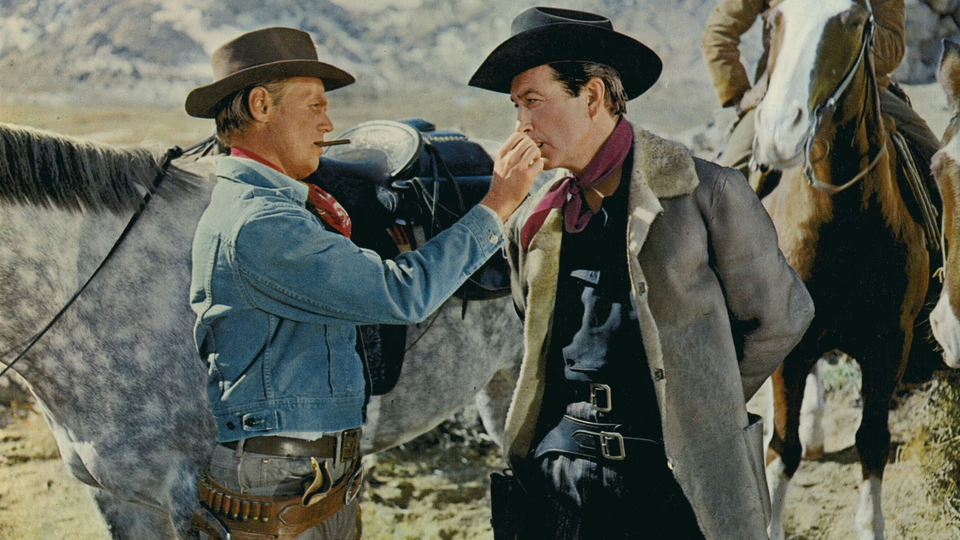The Law and Jake Wade

The Law and Jake Wade is a western from director John Sturges. Made between Gunfight at the O.K. Corral and Last Train from Gun Hill, this middling effort fails to rival the films that book-end it.
The story opens with Robert Taylor riding into town and busting Richard Widmark out of jail, where he’d been awaiting a hangman’s noose. We learn the pair were outlaw partners years prior, and that Widmark once saved Taylor from a similar fate.
Long estranged after a botched bank robbery, Taylor considers his debt repaid and returns home, where we learn he’s now a U.S. Marshal with a fiancée played by Patricia Owens.
Widmark and his gang show up and kidnap Owens, forcing Taylor to lead them to a stash of buried cash.
The film hinges on the Widmark-Taylor dynamic and, for his part, Widmark shines. He sports a perpetual half-smirk playing a deliciously cold-hearted villain who seems to relish being an evil son of a bitch. As Widmark would later say, “bad picture, good part.”1
Opposite him, Taylor disappoints. While he turns in a surprisingly physical performance highlighted by a shot where he dismounts a horse with his hands tied behind his back, his acting feels too stiff—particularly his scenes with Owens. He’s not so much bad as miscast. He’d make a great hard-boiled detective, but you sense this role needed a younger Randolph Scott.2
Fortunately, the supporting cast compensates. Widmark’s gang includes Henry Silva, DeForest Kelley, and Robert Middleton. Silva steals his scenes as a psychotic gunslinger with a chilling charm. In a performance that should amuse Star Trek fans, Kelley proves equally unhinged. Finally, Middleton brings a gravitas that bridges Taylor’s stiffness and Widmark’s outrageousness.
The script by William Bowers features some crackling dialogue. In my favorite bit, Taylor asks Widmark, “If things had worked out differently, were you gonna give me a gun, or shoot me in the back?”
After a beat, Widmark replies, “I was gonna give you a gun.”
Taylor nods, takes a pistol, and throws it down the street. “There’s your gun,” he says.
“I was gonna hand you yours,” Widmark says.
“Well, you like me better than I like you,” says Taylor.
But Bowers struggles with structure. After Widmark’s gang kidnaps Owens to force Taylor to lead them to the buried loot, the film settles into a tense, dark meditation on justice, loyalty, and redemption. Everything builds to a nighttime Comanche attack that should be the film’s climax but only ends the second act. Rather than bring the narrative to a head, it abandons the film’s themes and only serves to prune the supporting cast, rendering both it and the finale that follows contrived and underwhelming.
Sturges compensates for the script’s flaws and Taylor’s limits as best he can. He leverages the High Sierra locations and frames the mountains looming large in most shots, providing majestic vistas that dwarf the characters and lend an illusion of epic depth. For the Comanche raid, he tries to distract from the thematic and tonal shift by having the arrows and spears fly straight toward the cameras.
For the final showdown between Taylor and Widmark, Sturges leans into Taylor’s physicality, having the pair creep around an abandoned ghost town, guns drawn, in what’s essentially a high-stakes game of hide and seek. In a memorable shot, Sturges has a character enter a building through a window, creep through the darkened interior, and open the front door, revealing the ever-present Sierras and the bright sunlight.
But the combination of uneven structure and Taylor’s stiff performance keeps The Law and Jake Wade from greatness. It’s a solid picture buoyed by the location photography and dialogue, but folks would be better served with the uniformly strong performances of Gunfight at the O.K. Corral or the probing psychological depth of Last Train from Gun Hill before seeking out this lesser effort.
Notes
-
Glenn Lovell, Escape Artist: The Life and Films of John Sturges (Madison: University of Wisconsin Press, 2008), Kindle Edition, loc. 1897. ↩︎
-
Indeed, western fans may find themselves reminded of Sam Peckinpah’s thematically similar, but all-around superior Ride the High Country, which starred Scott. ↩︎